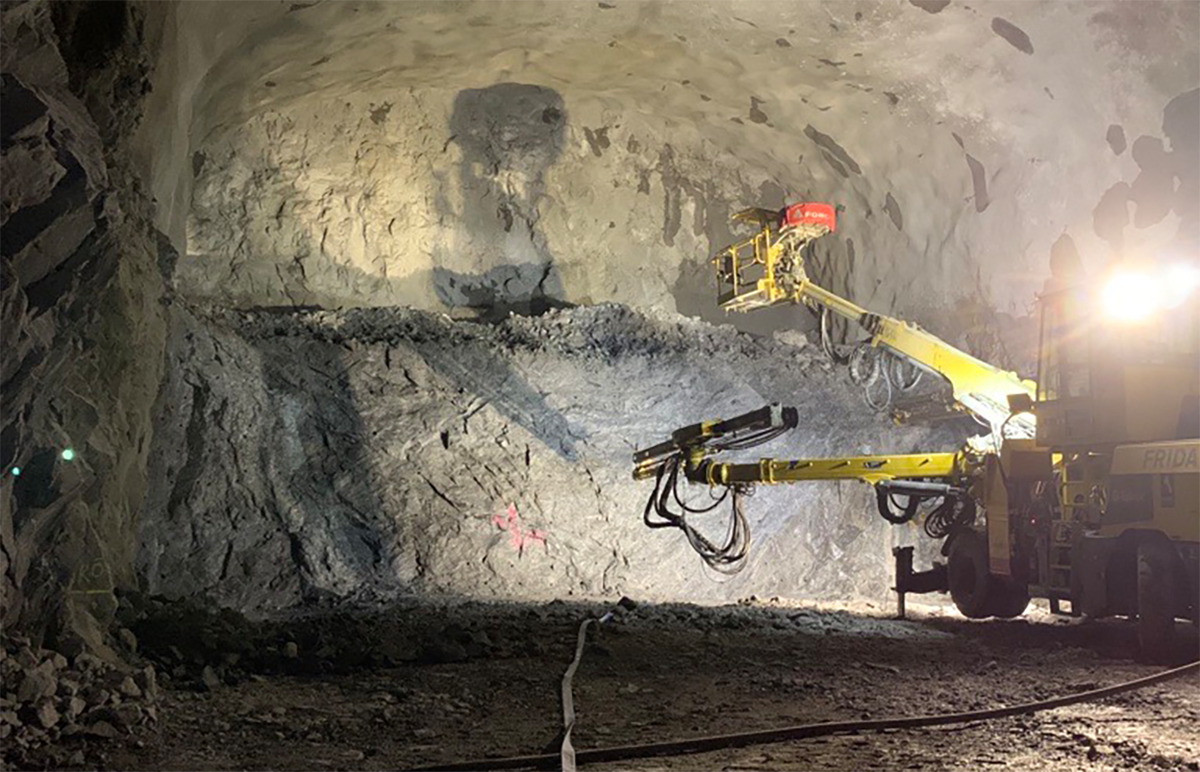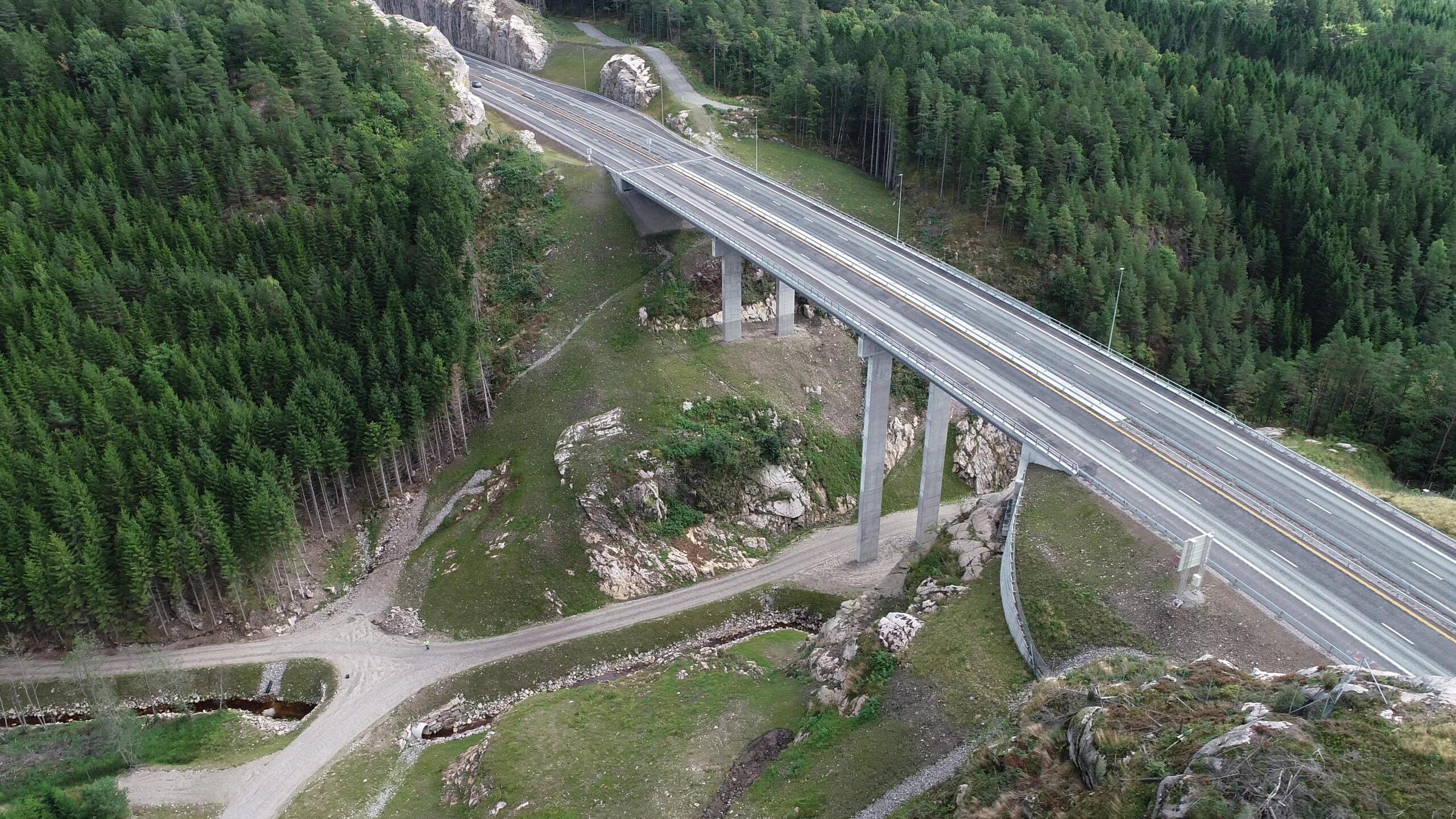CEEQUAL Very Good – Construction Only Assessment
Version 5, 2022 | Norway
Assessed by: Henning Fjeldheim, Skanska Norge
Verified by: John Logan, SCAPE
Client: Møre og Romsdal Fylkeskommune
Contractor: Skanska Norge
Project Summary
Fv. 659 Nordøyvegen is a mainland link that connects the Nordøyene north of the city of Ålesund to the mainland via sea embankments, underwater tunnels and bridges. Nordøyvegen provides a ferry-free connection to Lepsøya, Haramsøya, Skuløya/Flemsøya and Fjørtofta and Harøya.
The groundbreaking Nordøyvegen road initiative, featuring multiple bridges and a sub-sea tunnel, triumphed as the distinguished recipient of the prestigious Norwegian Civil Engineering Award 2022.
The Fv 659 Nordøyvegen K5 Skjeltene – Harøya contract mainly consisted of:
- Lepsøybrua, a 800-metre-long high bridge from Skjeltene on the mainland over to Lauka and Hestøya
- Laukebrua, a 110-metre long bridge
- Hamnaskjersundbrua, 200 meter long bridge in Hamnaskjersund
- The Haramsfjord tunnel from Hestøya to Austnes, 3 500 metres
- Marine deposits of excavated material on Lepsøyrevet, 800 000 m3
- Road on marine deposits of excavated material from Skjeltene to Hestøya, 2 700 metres
- Road and intersection at Austnes, 700 metres
- New road on Longva, 1100 metres
- The Nogvafjord tunnel, from Longva on Flemsøya to Fjørtofta, 5700 metres
- Fjørtoftfjord tunnel, from Fjørtofta to Myklebust on Harøya, 3700 meters
- Burberg tunnel, a tunnel preserve local wildlife on Fjørtofta, 170 metres
- Road on sea fill over Lepsøyrevet, 2700 metres
- New road over Fjørtofta, 3100 metres
- New road on Harøya, 1300 metres
- A dam with an asphalt core between Lauka and Hestøya, length 500 meters, height 12 meters

Metrics
| Embodied carbon emissions | 84 096 Tonnes CO2 equivalent | 8% reduction achieved |
| Re-used material | 140 000 tonnes | % of total material used |
Financial Benefits
Did the use of CEEQUAL deliver any financial benefits?
The most concrete financial benefit directly attributed to CEEQUAL was the engagement of the workforce leading to several “grassroot” reuse initiatives.
In your view, has CEEQUAL represented value for money?
The most important added value from CEEQUAL in this project is:
- transforming the sustainability efforts into something more tangible for the workforce, administration as well as the client. This in turn helps creating engagement
- forcing the project to set goals for an extended set of environmental aspects

Achievements
People and communities
Dialogue with the local community has been conducted at several levels as informal contact, local meetings pre-covid as well as questionnaires at regular intervals. Several issues recorded through the community engagement programme and during construction led to action to accommodate the requests in addition to planned proactive measures:
- Early establishment of asphalt on road with a lot of construction-related traffic passing through a small community to reduce dust and vibration
- Requests of contribution in the form of machines and excavated material to establish a running track and activity park at Fjørtofta
- Donation of a garage that was planned for demolition to an amcar club following a request
- Coordination regarding marine waste with Plastpiratene
- Donation of surplus material to an archery club at Harøya
Structured follow-up of the local community related to satisfaction with communication and site traffic through a targeted questionnaire at regular intervals. This also helped identify areas and aspects of focus. The percentage of respondents satisfied with site traffic has been stable at above 98,5% throughout the construction phase.
Ecology and Biodiversity
A tunnel was constructed at Fjørtofta to avoid disturbing a nesting ground for a known population of the Eurasian Eagle-Owl.
To accommodate the Eurasian Eagle-Owl a permanent landfill was reduced from 300 000 m3 to 200 000 m3 as a part of zoning planning in 2020 based on dialogue with a local ornithologist who had been monitoring the owl population in the area over the last decade.
The Water Environment
Prevention of marine plastic pollution is a major focus for the project defined by the client.
Plastic remains from the explosives used in the tunnel are deposited along with the excavated material in the sea. To manage the marine waste associated with the project a goal was established to become “Marine Waste positive”. There were two components of this strategy:
Minimizing the marine waste by:
- using electronic detonators reducing the quantities of plastic
- implementing routines to remove plastic remains before loading blasted rock on to trucks
Removing marine waste by:
- Implementing routines to collect visible plastic remains after depositing the excavated masses in the sea
- Arranging clean-ups
The total potential for plastic deposited in the sea as part of the project was calculated. The measured quantities collected as part of regular routines and clean-ups are 1,3 times larger than the maximum quantities estimated released.
The client identified a local grassroot organisation called Plastpiratene doing beach cleanups etc. as an important link. They were actively consulted during the construction phase by Skanska for example by monitoring any increased marine pollution during the construction period. Help has also been provided to disposal of marine waste collected by Plastpiratene. The feedback has been very positive and Plastpiratene has publicly given credit to the project.
Physical Resources
A reduction of greenhouse gas emissions of 7 373 tonnes CO2e was achieved. This equals 8% reduction.
The major contributors were:
- Products with low documented greenhouse gas emissions
- The use of the cover meter to measure the thickness of sprayed concrete over the rebars in the tunnel to reduce the necessary quantities of sprayed concrete.
- Boats connected to the electrical grid when docked
Engaging the workforce and suppliers of the project in sustainability on the operational level. This resulted in implementing measures that reduced the waste (excluding excavated material) by 420 tonnes.
The major contributors were:
- Avoiding demolition of the foundations for a temporary workshop and forwarding it to a neighbour for future use
- Donating concrete weights to local farmers etc., granite blocks to a sports team construction purposes, a complete garage to an Amcar club etc.
- Reuse of damaged ventilation ducts from tunnel construction as cover during the hardening of concrete
22 600 tonnes of excavated material was donated to local purposes including for example upgrading hiking trails and a running track
Beneficially reusing over 66% of excavated material and 100% of topsoils onsite.
Further Information
What were the main challenges for the project and how were these overcome?
The project covered sites spread over a relatively large area accessible only by boat before the end of construction. In addition it was located on the coast which makes it prone to weather. This required an efficient training program and rigorous follow-up to be able to manage all relevant sustainability aspects on the different sites.
What were the drivers and perceived benefits for undertaking a CEEQUAL assessment on this project?
The background for undertaking a CEEQUAL assessment on this project was the intention of following up the ambitions from the strategy phase in a structured manner as well as creating incentives to go beyond the minimum requirements.
How did the use of CEEQUAL influence the outcomes of the project? What was done differently because of the CEEQUAL process?
The main differences a result of implementing CEEQUAL on the project was structuring the follow up of the environmental goals on the project on a regular basis with the result of more people becoming engage with the sustainability efforts on the project.
What elements of this project highlight best practice and innovation?
The use of the cover meter to measure the thickness of sprayed concrete over the rebars in the tunnel to reduce the necessary quantities of sprayed concrete.

Quotes
“We were happy to see that the implementation of CEEQUAL on the project helped strengthen our sustainability ambitions. Especially on minimizing marine waste and greenhouse gas emissions.”
Marianne Nærø, Project Manager, Møre og Romsdal Fylkeskommune
“We are very proud of this spectacular civil project delivered under budget and ahead of schedule. In addition the project Achieved a CEEQUAL Very Good award for the construction phase. I am especially proud to see the engagement among the project workforce in sustainability matters”
Are Eliassen, Project Director, Skanska
BREEAM Infrastructure insights and case studies
Browse the latest insights, thinking and case studies from BREEAM Infrastructure

Stockholm Metro Nacka project awarded Excellent

Stockholm Metro Sofia access tunnel a BREEAM Infrastructure success

Stockholm Extended Metro access tunnel Sundstabacken achieves CEEQUAL Excellent rating

Preparatory works for the new water treatment system in Oslo achieves BREEAM Infrastructure Excellent rating

E39 Mandal øst – Mandal

